One of the goals for the Art of Slap Bass is to provide as much information and resources as possible for further development and study of the style. I’ve talked about it before, but the number of articles written on the subject is very low. Over time, we’ve republished a few, in my opinion, essential ones and we’re striving to gain permission to publish some other ones as well.
Adam Booker granted us a permission to publish his paper on slap bass notation he wrote over 10 years ago. When I read it back then, I knew I wanted to put it up on the AOSB as it might provide some valuable information for our readers. Please keep in mind that this paper is a result of Booker’s research and his point of view. It provides a different nomenclature system than our article “Basic Slap Bass Patterns“*. I have to mention that I really like Booker’s use of Gunter Schuller’s method of up/down stems for double hand slap patterns. Parts of this article have been published in Jazz Perspectives as part of Booker’s “Double Bass Techniques of the Early Jazz Era” study. We decided to publish this article in its entirety.
An Overview of Slap Bass History
At the beginning of the swing era, a new trend began to emerge. No longer relegated to be a mere accompanist, the double bass began adopting the role of soloist. Like a new species at the beginning of its evolutionary process, a variety of solo styles began to surface. The virtuoso arco improvisations of Slam Stewart and the horn-like pizzicato work of Jimmy Blanton, (a harbinger of what would become the normative model for bass soloists for the rest of jazz history) both vied for attention as the improvisational voice of the double bass. However, another contender remained: the slap bass style of Bob Haggart, Wellman Braud and Milt Hinton.
But just where did this style originate? Dan Meyers’ article, “New Orleans String Bass Pioneers,” originally published in Wavelength (republished at www.artofslapbass.com), shows that the genealogy of slap bass players traces directly back to the Crescent City at the dawn of jazz. Quoted in Meyers’ article, New Orleans bassist Albert Glenny (1870-1958) recounts that he “almost exclusively bowed during his early career [in New Orleans]” Meyers points out that Glenny was originally disdainful of the “pluckers and slappers.” However, according to Meyers: “By the time that Chester Zardis (1900-1990) started playing professionally a different attitude had developed. Zardis said that bowing was little used except on waltzes and slow tunes; slapping and plucking were necessary to give the music a real jazz feeling.”
In Meyers’ article, Hinton attributes New Orleans bassist Bill Johnson (1872-1975) as the father of the style. Johnson had been a New Orleans bassist who, like so many New Orleans Musicians of the era, eventually moved to Chicago. According to Meyers, Johnson was considered to be Chicago’s best bass man throughout the 1920’s, helping King Oliver put together his Creole Jazz Band.
Meyers also points out that “from the descriptions of ear-witnesses of the time, we know that some New Orleans musicians were already slapping the bass at least half a decade before the phonograph and the radio gave the genre national exposure. Listeners and fellow musicians recalled that Steve Brown had been playing his bass slap style with the New Orleans Rhythm Kings in the early 1920’s.” By 1926, according to Meyers, Brown had recorded a number of works with Paul Whiteman and Jean Goldkette. With this exposure, as Meyers points out, “the string bass revolution now had the mass media of the time behind it, and [it] spread rapidly.”(Meyers)
As we move into the swing era, the bass has firmly taken the place of the tuba as the low-end instrument of choice within the big band scene. There were several notable bassists of this era, such as Bob Haggart (1914-1998), who performed with Bob Crosby and his Bob-Cats. Haggart’s “Big Noise from Winetka,” which became a hit single in 1938, (Schuller, 654) has also become a standard part of slap bass repertoire. Wellman Braud (1891-1966), bassist for Duke Ellington prior to the “Blanton/Webster” years prominently employed slap technique both as an accompaniment, with single and double slaps in his walking lines in pieces such as “It Don’t Mean a Thing if it Ain’t Got That Swing” and as a solo style technique in “Blue Harlem.” Finally, Milt Hinton (1910-2000), who performed with Cab Calloway. Schuller states “One large reason for the rhythmic stability and drive of the Calloway band was its bass player, Milt Hinton, with the band from 1936 until it disbanded. No bass player has worked harder and more devotedly at his craft, constantly improving.” (Schuller, 349)
As popular as this style became during the swing era, it was soon supplanted by the pizzicato of the be-bop bassists, no doubt influenced by the improvisatory style of Jimmy Blanton. However, the technique of slap bass didn’t entirely disappear. It simply moved on to other forms of music. For instance, the blues musician and bassist Willie Dixon (1915-1992) prominently featured his slap technique in his recordings. Bill Black (1926-1965) slapped his bass for Elvis Presley’s “Sun Studio” sessions, setting the bar for rockabilly and country/western bassists to this day. According to Stokes, the technique began to be featured and perform in various genres by the 1950’s. (Bass World, p.9)
Nor did the style disappear entirely in the jazz idiom. It remained dormant in the style but was not forgotten. One video of Ray Brown shows him demonstrating slap technique (to a high degree of facility) in the 1970’s. Furthermore, slap bass enjoyed a resurgence of attention amongst the jazz world by the 1990’s primarily due to a series of well received recordings made by Milt Hinton. The style comes full circle with the 2003 release by New Orleans bassist Roland Guerin, Groove, Swing, and Harmony.
Basic Slap Bass Nomenclature and Notation
In order to analyze and discuss this unique technique, it is necessary to quantify and normalize the basic nomenclature and its respective notation. Fortunately, there is a precedent for this. In The Swing Era, Gunther Schuller transcribed a passage of Milt Hinton’s introduction to Roy Eldridge’s “Pluckin’,” which “features an intricate technique peculiar to string instrumentalists-and analogous to one developed by Niccolo Pagannini in the early years of the 19th century.” (Schuller, 345). In this transcription, Schuller delineates between the “Pluck” and the “Slap” by notating the “pluck” (also known as a “snap pizzicato” or “Bartok pizzicato”) with a traditional note head and the “slap” (the physical act of the palm of either hand hitting the fingerboard) with an “x” for a note head, indicating the percussive aspects of this technique. Furthermore, Schuller also separates the right hand from the left hand slaps by stem direction (stems up = right hand slap, stems down = left hand slap). It is important to note for the purposes of this analysis, the piece represented (“Back Home Again in Indiana”) comes from an audio recording, and as such, no determination can be made at this time whether or not Hinton was employing both hands in his performance. Therefore, this transcription is notated as though the slaps were performed “right hand only.”
Further research into slap bass techniques by both Serbian Bassist Djordje Stijepovic and Dr. Donovan Stokes (Shenandoah Conservatory, Winchester, VA) has identified five basic elements (Snap, and three primary Slaps) in slap bass performance. The identification of these basic units of slap technique, along with notational precedence set by Schuller and John Goldsby (who also has a transcribed solo by Milt Hinton in his book: The Jazz Bass, Technique and Tradition) form a basis for a quantifiable notation system:
- Snap: Also known as the “Snap Pizzicato” or “Bartok Pizzicato,” (From Bartok’s String Quartet number 4) and, in the case of Schuller, the “Pluck,” this technique requires the performer to pull the string away from the finger board, allowing it to rebound against the fingerboard, resulting in a combination of both pitch and percussion. Stokes explains that this is often confused with a single slap. In classical literature, this is generally notated like this:

Stokes employs this notation in his slap bass etudes available at www.notreble.com. However, given the intricate nature if slap technique, attaching this symbol to every intoned note would cause a great deal of clutter on the page. We can easily negate this by simply marking “Slap Style” (with appropriate reference to the Bartok pizzicato in a key), while marking “pizz” for non-slap sections to differentiate between the two articulations.
- Slap: This is the physical act of the hand hitting the fingerboard. There are several sub- classifications to this technique:
- Single Slap: A single hit to the finger board:
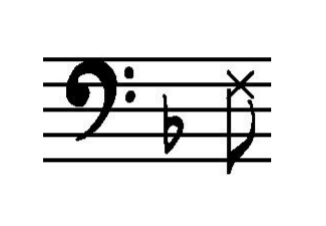
The single slap is almost always preceded by a snap:
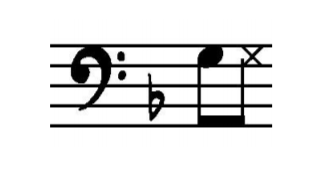
A typical use of the single slap is to accentuate beats two and four in a two-beat feel:

In this case, the note heads can be played either with a snap pizzicato or a regular pizzicato. However, in the next particular variation of the single slap, the note head is played with the snap pizzicato:

Stokes calls this a “snap/single slap shuffle,” but slap shuffle will suffice. In the case of Hinton’s solo , the single slap is utilized to add a percussive component to the walking bass line:

However, to create more syncopated passages, Hinton employs a “reverse single slap”:

2. Double Slap: Two hits to the finger board:
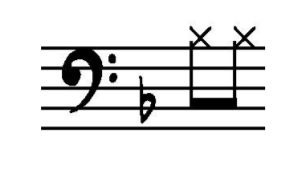
Like the single slap, the double slap is also preceded by a snap, usually a quarter note:
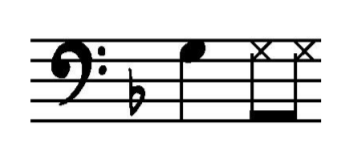
Similar to the percussive element of the single slap, Hinton utilizes this method to rhythmically enhance a “two-beat” feel:
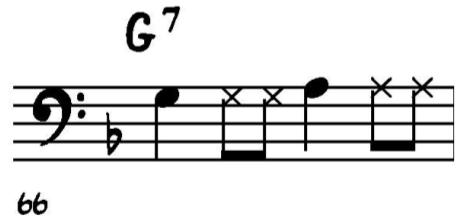
3. Triplet Slap: One snap followed by two hits to the finger board in triplets:
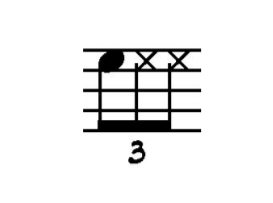
This is also referred to by Stokes and Stijepovic as the “Drag Triplet” or “Gallop.” Hinton tends to employ this particular unit to accentuate beats two and four in a measure, as seen here at measure 24:

4. Quadruple Slap: One snap followed by three eight note hits to the finger board:

In Hinton’s solo, we see the quadruple slap employed most often at formal boundaries, such as the beginning of the second trading chorus:

Building on these rhythmic cells, patterns can be developed based on syncopated musical patterns prevalent throughout the swing era. For instance, an example of a two beat syncopation based on the double slap used by Hinton:
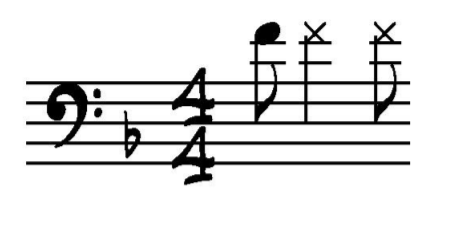
As well as this variation on the same rhythm:
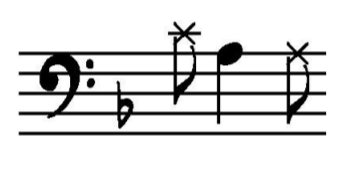
Another example, by combining single slaps and reverse single slaps, is the often employed “Rhumba” slap:

Advanced Slap Notation
As mentioned earlier, because the particular solo in question came from an audio source, it is difficult to distinguish between “right hand only” or right hand/left hand variations. Again, Schuller gives an appropriate guide to notation for these variations. For example, Hinton employs a triplet slap here at measure 87:
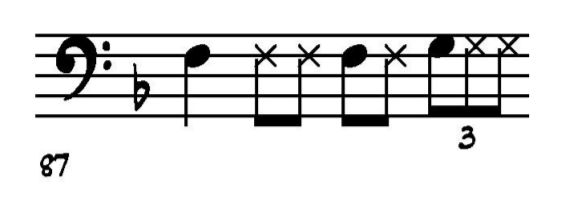
By utilizing Schuller’s notation from The Swing Era, using an upward stem to denote the left hand and a downward stem to denote the right hand this passage can be re-written like this:
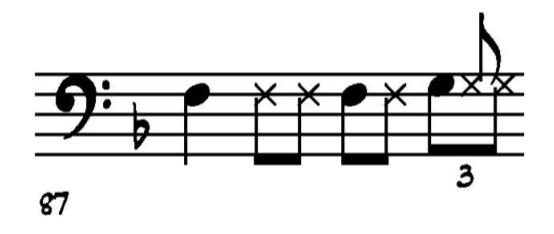
This technique can also be applied to Quadruplet slaps:
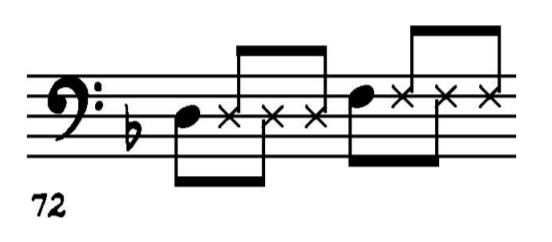
Another technique referred to by Stijepovic and Dr. Stokes is the “drag slap,” usually used to to denote a common triple slap. However, this term is could cause some confusion when one takes into account the various percussion-like flam attacks prevalent throughout the style. These techniques are often employed before the note occurs by literally dragging the palm of your right hand across the finger board and hooking your finger to the string on which the note is to be played, creating a percussive “flam.” Instead of using the term “drag slap” to identify this technique, I will use the term “flam slap.”
- Single Flam Slap
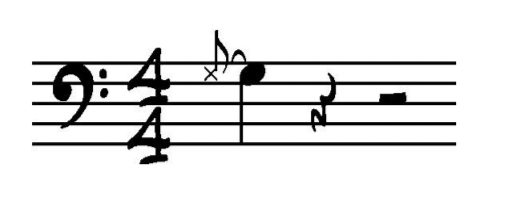
- Double Flam Slap
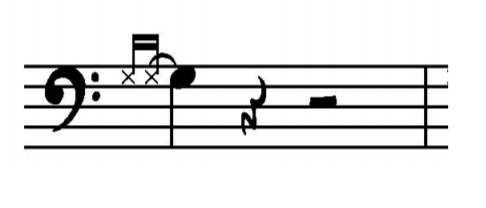
- Triple Flam Slap
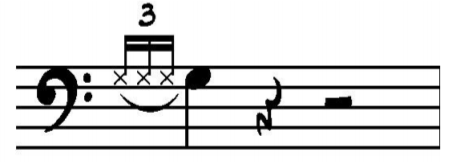
Due to tempo considerations, it may be difficult to distinguish between a flam slap or a single slap (or even a double or triple slap) being used as a pick up. This is the case in “Indiana” at measure 30:
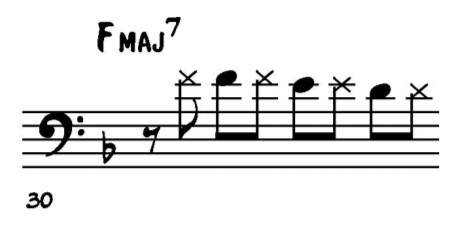
Utilizing “flam slap” notation, this passage could easily be heard and re-written like this:
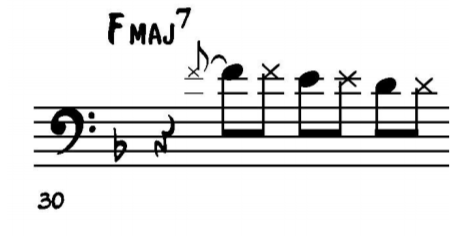
It is important to note how these units are beamed. In an attempt to blend the nomenclature of Stokes and Stijepovic with the notation of Schuller and Goldsby, the beaming above implies that these units are elemental structures. Hence, single slaps are beamed with their antecedent or consequent note, and likewise for triplet and quadruplet slaps. We can view these stand alone structures as rhythmic cells with which more complex combinations and variations may occur. Furthermore, by treating these patterns as rhythmic cells, we can apply this notation to related subdivisions, giving us the ability to notate a double-time slap solo. For example, the double slap “cell” can be applied to a 16th note subdivision:

Because of this, the rhythmic cell system of notation offers us an opportunity to more accurately transcribe slap bass solos from the swing era.
Works Cited:
Goldsby, John. The Jazz Bass Book, Technique and Tradition. San Francisco:
Backbeat Books, 2002.
Meyers, Dan. “New Orleans String Bass Pioneers.”
https://www.artofslapbass.com/new-orleans-string-bass-pioneers/ (accessed April, 13 2011).
Schuller, Gunther. The Swing Era. The Development of Jazz, 1930-1945. New York: Oxford University Press, 1989.
Stijepovic, Djordje. “Basic Slap Patterns.”
https://www.artofslapbass.com/basic-slap-bass-patterns/ (accessed April 13, 2011).
Stokes, Donovan. “Introduction to Slap Bass: History, Setup, and Technique.”
Bass World 32, no. 2 (2008): 9-13.
Stokes, Donovan. “The Lowdown with Dr. D: Upright Slap Bass: Starter Tips and Etudes.“
http://www.notreble.com/buzz/2010/02/15/the-lowdown-with-dr-d-upright-slap-bass-starter-tips-and-etudes/ (accessed April 13, 2011).


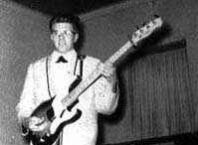
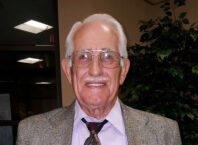
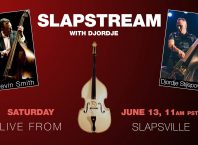
This is a great, informative article. I agree that the Bartok pizz notation can make the notation very cluttered at times.
I was thinking that instead of “Slap Style,’ we could also come up with a different abbreviation that could be the Bartok version of “pizz.” Maybe something like “b. pizz.” or “btk. pizz.” that marks each section as slap style.
Excellent Article, thank you.